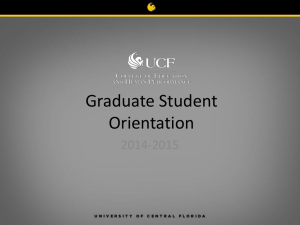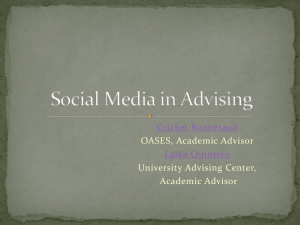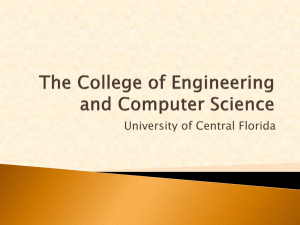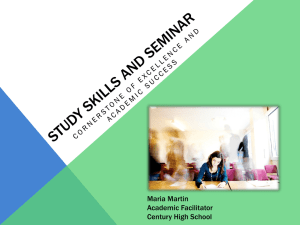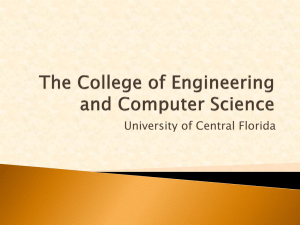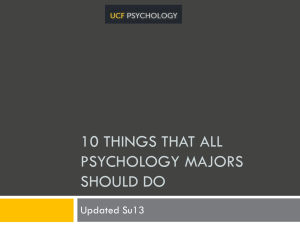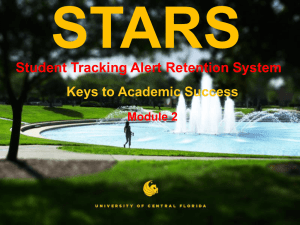Transfer Shock
advertisement
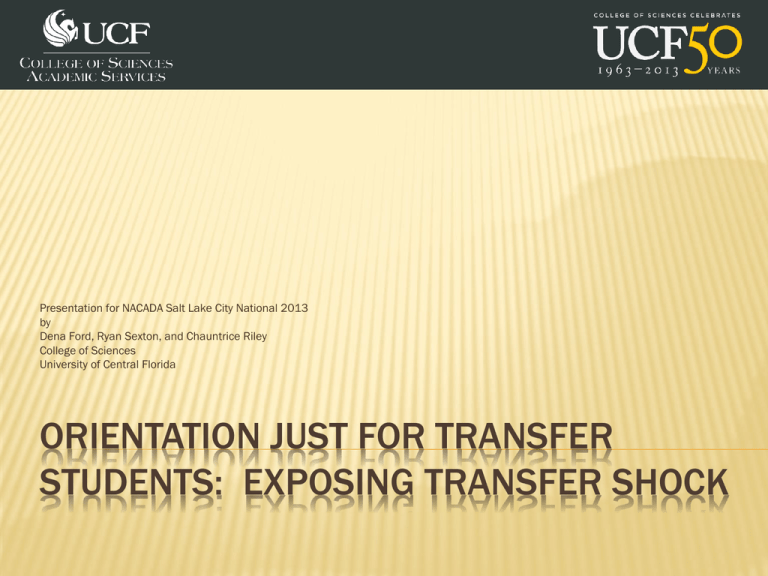
Presentation for NACADA Salt Lake City National 2013 by Dena Ford, Ryan Sexton, and Chauntrice Riley College of Sciences University of Central Florida ORIENTATION JUST FOR TRANSFER STUDENTS: EXPOSING TRANSFER SHOCK PRESENTATION OBJECTIVES Provide motivation for institutional modification of a long-held schedule Demonstrate key elements of COS interactive workshop developed specifically to expose new transfer students to “Transfer Shock” phenomenon. Show results of learning outcomes and plans for expanding transitional advising throughout first semester. SOME BACKGROUND INFORMATION The University of Central Florida (UCF) The College of Sciences (COS) Transfer students make up approximately half of UCF’s and COS’s student population AA Transfers Consortium Agreements with UCF Transfer Orientations – one full day (9-4) College 75 min. advising: 30 min./Dept. schedule-planning MOTIVATION FOR CHANGE “Deferred” Acceptance Four colleges presented data from Fall 2009 Results: Over 33% of the new transfers placed on probation first semester were within the “deferred” groups. (COS: over 54%!) Presented results to higher administration ACTION TAKEN SO FAR Task Force formed at request of Higher Administration to discuss results and make recommendations Decision was made to change schedule of Transfer Orientation to allow for longer advising sessions College advising: 80 minutes/ Dept. schedule planning unchanged (75 minutes) How can we best use this time to help transition students more successfully? FOCUS ON AVOIDING TRANSFER SHOCK Raise awareness of the “Transfer Shock” phenomenon Reinforce in two presentations University presentation: done by Transfer and Transition Services office College advising presentation: for COS, students are split up into 4 groups, each led by their assigned college advisor Focus on initial transition: “First week survival” Measure learning by way of pre- and post-tests THEORETICAL BACKGROUND • Developmental Identification Model • • • Derived from Erik Erickson’s Identity Model Stage 5: Identity vs. Identity Diffusion (Confusion) Unrealistic Expectations (Incongruencies) Vs. Realistic Identification (Successful Transition) Signs of inadequate transitioning through Transfer Shock (Incongruencies) Appreciative Advising techniques can help guide transfer students toward a more realistic identification VISUAL SIGNS & PATTERNS Behavior-Based Learning/Model Builds in layers through unrealistic expectations Progressive in nature = unrealistic expectations pick up sediment, or additional incongruent behaviors A-B-C A: Antecedent Behaviors appear calm though antecedent factors, such as lack of support, financial hardships, or the family crisis, are a catalyst to the behavior that begin the ripple effect. A-B-C B: Behavior The antecedent gives rise to the observable behavior. Unrealistic expectations are building, outreach is crucial at this time. A-B-C C: Consequence Avoidant and negative behavior leads to destructive consequences. Triage is necessary at this layer. Help student accept the fallout. PRE-ORIENTATION OUTREACH E-mail to transferring students - - - UCF’s Orientation Services office provides all the colleges access to run their own reports from the orientation database. Prior to each orientation session, a list of expected attendees is generated. Includes link to COS on-line Student SelfAssessment. ORIENTATION WORKSHOP OUTLINE I. II. III. IV. V. Transitioning to UCF and Pitfalls of Transfer Shock Basic student degree elements and tools Policies – activity Student Rights & Responsibilities - activity First Week Survival Welcome to UCF! Please complete the COS Orientation Questionnaire while waiting to get started. Thank you, Your COSAS Advising Team ORGANIZATION OF THE UNIVERSITY University: UCF Colleges: College of Sciences Departments/Schools: Eg. Chemistry Department / Nicholson School of Communication Majors: Eg. Psychology Minors (required and/or optional): Eg. Statistics Certificates (options): Eg. Behavioral Forensics Selecting a Major ? Selecting a Major • Why discuss when you already have a major? • The average student changes majors 2 to 4 times • Change your major if it is not right for you! • Note: Must adopt current catalog if you switch Transfer Shock A drop in the transfer student’s G.P.A. during the first semester at the new institution (National Academic Advising Association) IT’S REAL CHANGE IS GOOD CHANGE CAN BE STRESSFUL Unrealistic Expectations vs. Realistic Identification Warning Signs Realistic Identification Unrealistic Expectations • Class sizes won’t be a problem. • Acknowledge class size. Don’t get lost in the numbers. • I don’t need to show up for every class. • Retention of info in lectures means competence in your field. • I need to load up my schedule so I can graduate on time. • Create a plan of study for your first 2 terms with an advisor. • I don’t need to look at my degree audit. I know what I need to take. • The University uses the degree audit as a graduation reference. Mark Your Calendar • Drop/Swap and Add • Grade Forgiveness • Withdraw – academic standing policy Time Management Reality Check Activity First Week Survival • • • • • • “Don’t go into Transfer Shock!” tips sheet Parking in first week – permits Classroom locations Don’t overload Campus Resources Auditorium Size Classes College of Sciences Academic Services (COSAS) CSB 250 407-823-6131 undergrad.cos.ucf.edu Office Hours: M-Th 9-5 F 9-12 HOW ARE STUDENTS RESPONDING? COS Transfer Orientation Presentation Survey List 2 things you learned from this presentation Post-test (same as Pre-test) to measure student learning outcomes POST-ORIENTATION OUTREACH In development: Transfer Success Seminar Will include timely communication plan, including social media, over the first semester according to the COS Advising Syllabus Will study differences among majors (ex. are STEM majors having more trouble transitioning than Social Sciences?) Develop more pre-transfer programming with Consortium Schools (e.g. academic maps for each major incorporating each schools AA requirements) RESULTS OF STUDENT LEARNING OUTCOMES Pre- and Post-Test Results Summary: Most students learned about Transfer Shock in first presentation and could answer correctly in pre-test (93%). Awareness of how often students should see an advisor jumped from 55% to 80% (+25%). Awareness of academic progress tool increased from 77% to 94% (+17%). Understanding differences of GPAs and which ones determine academic standing increased from 66% to 87% (+21%). CHANGE IN TRANSFER PROBATION RATES Fall 2009 Fall 2012 Total COS Transfers: 1074 1337 Placed on probation after 1st semester: 259 (24%) 112 (8%) Deferred COS transfers (borderline 2.0 GPA): 141 (54% of 259) 41 (37% of 112) Questions? Dena.Ford@ucf.edu Ryan.Sexton@ucf.edu Chauntrice.Riley@ucf.edu

